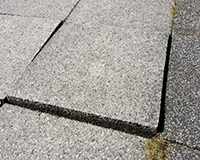Legal Notes James Driscoll addresses the scope of a landlord’s liability for property defects
Key points
- Landlords are liable for defects to the structure and the exterior of a building
- Where the defect is in the demised area the landlord must have notice or it will escape liability
“One summer evening in 2010 Mr Edwards was taking rubbish out from a second-floor flat which he and his partner rented from Mr Kumarasamy. He tripped over an uneven paving stone in the pathway between the front door of the block and the communal bins in the car park, as a result of which he injured his knee.”
So begins the recent decision of the Court of Appeal in Edwards v Kumarasamy [2015] EWCA Civ 20; [2015] PLSCS 30, which illustrates the scope of a landlord’s repairing obligations when letting residential property. Baladas Kumarasamy is not the owner of the freehold of the block but a leaseholder of the second-floor flat, which he let to Samuel Edwards and his partner under an assured shorthold tenancy.
Under his lease, Kumarasamy has rights to use the entrance hall, the stairway and lift, and other communal areas. Responsibility for the repair and the maintenance of the block rests with its owners but their responsibility under the lease is restricted to cases where a leaseholder has given them notice of
any defect.
It was common ground that Edwards did not give notice to Kumarasamy; nor did Kumarasamy give notice to his landlords, the owners of the building (it is possible that neither of them were aware of the defect).
Implied repairing covenants
Under the tenancy, the repairing covenants implied by the Landlord and Tenant Act 1985 (“the 1985 Act”) applied. As a result of his injuries Edwards sued Kumarasamy for damages alleging breach of the repairing covenant. He succeeded at first instance, deputy district judge Gilman finding that the paved area between the front door to the building and the car park was part of the structure and the exterior of the block. Damages of £3,750 were awarded.
However, this was reversed by Judge May QC, who allowed a different point to be raised: that Kumarasamy was in breach of the extended covenant implied by section 11(1A) of the 1985 Act. But the judge decided that there was no liability as Kumarasamy had not been given notice of any defect. Edwards appealed.
The Court of Appeal unanimously allowed the appeal and Lewison LJ gave the decision. Two issues had to be decided: was the area within the implied repairing covenant and did the landlord have to have had notice as a precondition of liability?
Structure and exterior
Was the paved area where Mr Edwards tripped part of the structure or the exterior of the building to which the 1985 Act covenant applied? In Brown v Liverpool Corporation (1983) 13 HLR 1 the Court of Appeal decided that steps leading to the front door of a building were part of its exterior. Although in that case the whole of the building was subject to the tenancy, in this case the paved area could properly be treated as the exterior of the hall in the block containing the flat.
The notice rule
The next issue was whether liability was conditional on the landlord having notice of the defect. It was noted that the position at common law is that the covenant to keep premises in repair requires the landlord to keep them in repair at all times (British Telecom plc v Sun Life Assurance Society plc [1995] 2 EGLR 66).
But the position is different where the defect appears in the demised premises themselves, where the landlord can only be liable if it has notice. This is the principle that was firmly restated by the House of Lords in O’Brien v Robinson [1973] AC 912; [1973] EGD 296, where it was applied to a case in which the occupiers were unaware of a defect, so they could not report it to their landlord. The defects in that case were within the premises demised by the tenancy (a ceiling area in their flat). As the landlord was not given notice, it had no liability to compensate the tenants for their injuries and losses.
The reasoning underlying this principle is that the landlord has only limited rights of access to the premises demised under the tenancy, so it is right that it should not be liable for any defects without notice of them.
Whether something is part of the structure and exterior of a dwelling depends on the facts and it is not limited to what has been demised under the tenancy (Campden Hill Towers Ltd and
another v Gardner and another [1977] 1 EGLR 23).
The court concluded that the notice rule only applies to a defect that arises within the demised premises. In this case the defect arose to the paved area which forms part of the structure and exterior of the demised flat.
Defects in such an area do not require the landlord to have notice as a precondition of liability. The court expressed its disagreement with the contrary conclusion reached by Dowding & Reynolds, the editors of the leading textbook Dilapidations: The Modern Law and Practice (5th edition at paragraphs 20-37).
This case is a useful reminder that a landlord’s liability for breach of a repairing covenant to a part of the structure and the exterior of a dwelling that is not part of the demise does not depend on the landlord having notice of any defect. It also reminds us that there is no liability for defects within the area demised unless the landlord has notice and – as the O’Brien decision shows – this applies to latent as well as patent defects.
Professor James Driscoll is a solicitor and a writer








